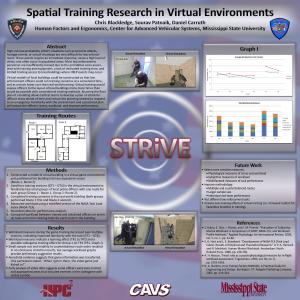Publications at the HPC²
Publication Abstract
Spatial Training Research in Virtual Environments
Blackledge, C., Patnaik, S.S, & Carruth, D. W. (2008). Spatial Training Research in Virtual Environments. Proceedings of Applied Human Factors & Ergonomics International . Las Vegas, NV.
When law enforcement tactical teams enter a hostile building in order to eliminate threats they are performing a very complex and highly demanding task. Not much can be done to alter these high-risk low-probability situations, but training for these events can improve performance by allowing more mental resources to be dedicated to the dynamic task requirements. Using virtual training simulations can lower the stress and workload of the officers by familiarizing them with the environments they must operate in. In this study eight police tactical team officers participated in a spatial training experiment that consisted of four virtual environment training sessions and two real world test sessions, where they eliminate terrorist threats from an environment using normal tactical methods. A modified version of the NASA-TLX was used to measure the workload of officers during each stage of the experiment. Changes in workload over the virtual training periods were analyzed to determine if the officers became more familiar with the task and the virtual environment. Using workload measurements from the real world trials, a comparison was done between the trained and untrained officers to determine if spatial training had an effect. The NASA-TLX allows the overall workload measure to the broken into different elements such as mental demand, physical demand, temporal demand, performance, effort, and frustration. This element separation allows a more detailed analysis of the participants’ performance to be achieved. Being able to determine specific contributing elements of workload will allow researchers to make more efficient changes to training practices and improve task performance. Anecdotal evidence and timed performance measures were gathered to verify that spatial information was transferred during the training sessions. Developing an efficient and low cost method to train officers on many local building layouts will result in improved officer safety and performance during high risk situations.

